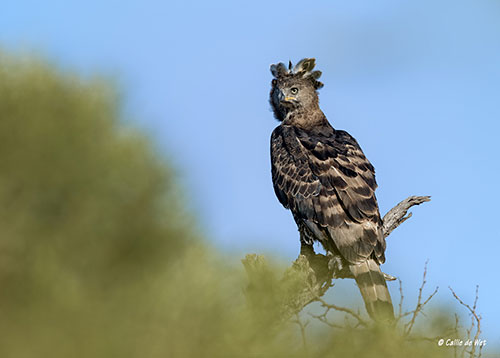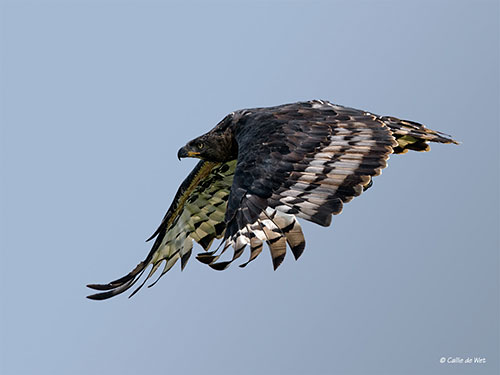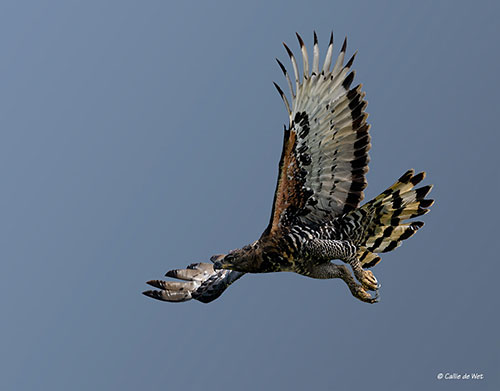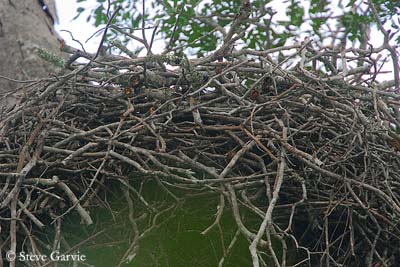
Crowned Hawk Eagle - African Crowned Eagle - Crowned Eagle
Stephanoaetus coronatus
Accipitriforme Order – Accipitridae Family
BIOMETRICS:
Length: 81-99 cm
Wingspan: 180-200 cm
Weight: F: 5 kg - M: 4 kg
LONGEVITY: Up to 15 years
DESCRIPTION:
Crowned Hawk Eagle is certainly the most powerful African raptor.
It has huge and sharp talons at the tip of its muscular feet and feathered legs.
Crowned Hawk Eagle has dark grey upperparts. Underparts, breast and belly, are rufous, heavily mottled with black and white.
Wings are broad and relatively short, with chestnut underwing coverts, and dark grey and white stripes. With these wings and its long tail, Crowned Hawk Eagle is able of much manoeuvrability into its environment.
Face is dark grey with yellow eyes. It has strong, hooked, almost blackish beak. It has a crest on head, mainly above the eyes, giving it a cat-like attitude.
Female is larger than male, with shorter crest and more barred underparts.
PROTECTION / THREATS /STSTUS:
Crowned Hawk Eagle is a protected species. It is not hunted, but it is mainly threatened by habitat destruction.
Fr: Aigle couronné
All : Kronenadler
Esp : Águila Coronada
Ital : Aquilastore coronato
Nd : Kroonarend
Russe : Венценосный орёл
Photographe :
Steve Garvie
RAINBIRDER Photo galleries
Callie de Wet
GALLERY
Texte de Nicole Bouglouan
Sources :
HANDBOOK OF THE BIRDS OF THE WORLD Vol 2 by Josep del Hoyo-Andrew Elliot-Jordi Sargatal - Lynx Edicions - ISBN: 8487334156
BIRDS OF AFRICA SOUTH OF THE SAHARA by Ian Sinclair and Peter Ryan - Princeton University Press Princeton and Oxford - ISBN: 0691118159
BIRDS OF PREY OF AFRICA AND ITS ISLANDS by Alan and Meg Kemp - Struik Publishers - ISBN: 1770073698
Wikipedia (Wikipedia, The Free Encyclopedia)
BEHAVIOUR:
Crowned Hawk Eagle is sedentary, and normally it remains in the same area, but occasionally, it moves some distances.
Pair of Crowned Hawk Eagles has a hunting range of several squares miles of forest, or a small area on rocky hills or cliffs, where hyraxes (Procavia capensis) are numerous.
The bird is often perched on a tall tree, looking for prey around it, in early morning and evening. It spends much time soaring over the forest, searching for monkeys feeding on tree-tops.
It drops down onto the prey from a perch, flying silently from perch to perch. Most of its preys are killed on the ground, except the monkeys caught in tree-tops. It is able to fly almost vertically after hunting, but sometimes, it tears up prey on ground.
A good-sized animal is killed every 3 or 4 days. It strikes the prey with its powerful talons. The victim is paralyzed, squeezed to death, and then, eagle dismembers it with its hooked bill.
FLIGHT:
Crowned Hawk Eagle has short and broad wings, and a long fanned tail, giving it the possibility to lift-off vertically when it is hunting in closed forest. Male has more rapid wing beats than female. They can soar very easily over the tree top.

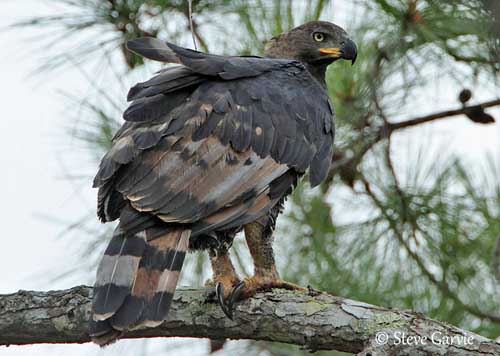
HABITAT:
Crowned Hawk Eagle lives mainly in forest, but it can be found on rocky hills and along riverine forest strips. It can live from the sea level to 3000 metres and more.
RANGE:
Crowned Hawk Eagle lives in Africa, South of Sahara, from Senegal and Guinea in the west, across to Ethiopia in the east, and in south African forests. It is a common resident.
Female performs the same display, but less often, with a softer voice. Pair can also perform stunning mutual displays. Male flies down towards female who turns on the back to present its claws to the male. They can repeat 5 or 6 times this display.
Copulation occurs at nest, several times a day. During the pre-copulation, male runs around female who is crouched, with upraised wings to display the beautiful pattern of its underwing coverts.
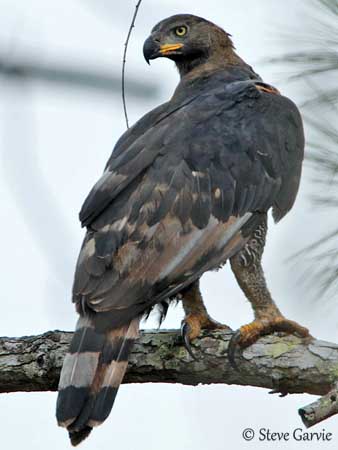
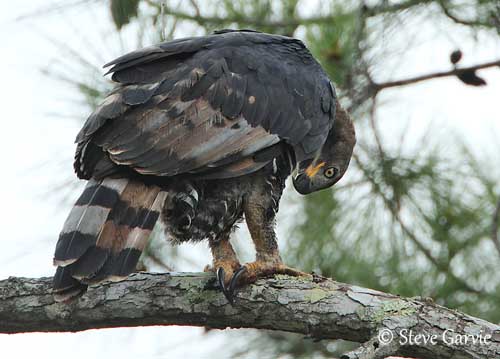
Crowned Hawk Eagles mate for life.
Female lays 1 or 2 white or creamy eggs, between July and October. Incubation lasts about 49 to 50 days, by female. During this period, male brings food at nest. Chick eaglet is quiet when hatches, but it becomes active very soon. When two young hatch, generally, the smaller succumbs. First feathers appear at about 40 days, and they cover the down at 76 days. Crest appears at 60 days. Tail and wing quills reach their development after 76 days.
Flight exercises begin at 45 to 50 days, and are increasing until 75 days, stimulated by winds. They fledge at about 103 to 115 days.
Young males climb on the branches of the tree, and jump from it to perform their first flight. Females make their first flight without any exercises.
After the first flight, eaglets probably return to roost at nest. They are fed by both parents who bring food at intervals of 3 to 5 days, for 9 to 11 months after fledging.
Both parents remain in the vicinity of the nest, perching on trees, and roosting near the nest site. Young become independents when the food brought by parents is ignored.
This species breeds every two years, and young reach they sexual maturity at about 4 years.
DIET:
Crowned Hawk Eagle feeds on 98% mammalians, with sometimes reptiles such as lizards or large snakes.
It feeds mainly on monkeys, but also takes small antelopes (up to 44 lbs) and hyraxes, mongooses and domestic cats.
Birds are rarely taken, and it does not take poultry.
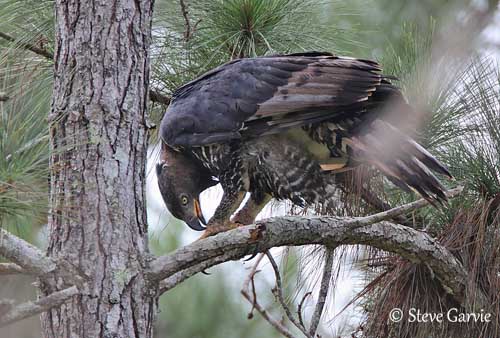
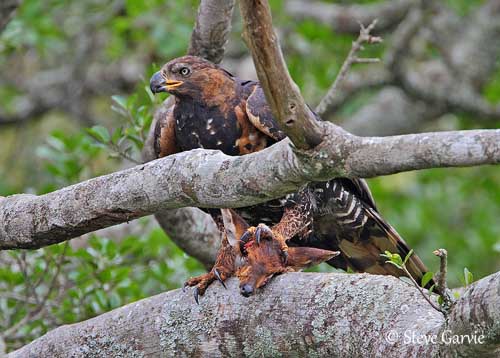
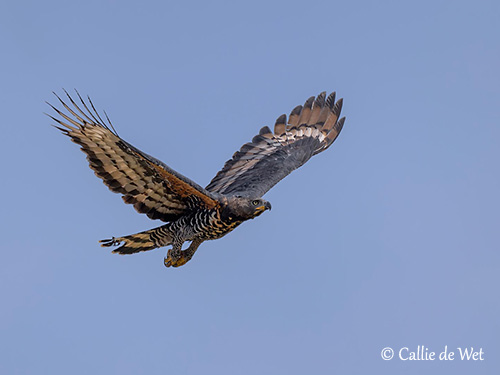
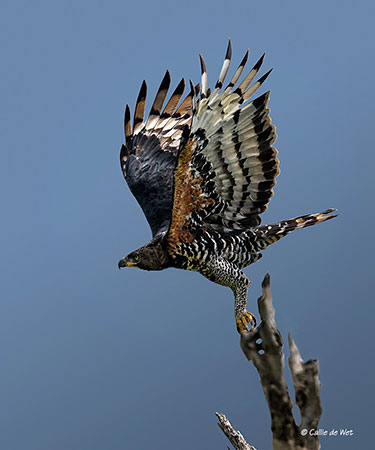
Juvenile is paler than adults. It has whitish head and underparts, with rufous tinge on breast, pale grey upperparts and strong-barred tail, black and white.
Legs are feathered, whitish mottled with black. Eyes and bill are dusk. Talons are pale yellow.
VOICE: SOUNDS BY XENO-CANTO
Crowned Hawk Eagle utters some high pitched calls during flight display, a rapid “ki-ki-ki-ki-ki”, and a “kewee-kewee-kewee” during a distinctive pendulous aerial display.
Female utters a lower and musical call “khoi-khoi-khoi” when on the nest.
At nest, both adults utter a shrill “quee-quee-quee-quee” while they bring food. Young answer with the same kind of calls.
